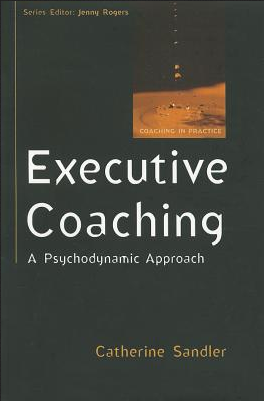Executive Coaching – A Psychodynamic Approach: Catherine Sandler
 The book is written for coaches who want to know more about psychodynamic psychology and how to use psychodynamic insights to help their clients. The introduction to the book by Jenny Rogers, the Series Editor, says:
The book is written for coaches who want to know more about psychodynamic psychology and how to use psychodynamic insights to help their clients. The introduction to the book by Jenny Rogers, the Series Editor, says:
“Catherine’s book is a practical, readable guide, written by one of the UK’s most experienced and successful executive coaches. In it she explains, with the help of many case studies drawn from her practice, how to apply psychodynamic ideas.”
Key themes and ideas
Sandler is clear that psychodynamic ideas can be applied to the client’s work issues without the coach stepping into therapeutic territory and without having to hunt for any possible root cause in the client’s personal history. Hers is a very “here and now” and practical coaching approach. A major appeal for me of this book is Sandler’s awareness of her own coaching style and her clear description of it. She describes her style as “highly interactive and quite directive at times.” She says:
“I go beyond providing clients with a safe space and asking skilful questions. When necessary, I lead the process, taking the initiative and directing the client towards themes, insights and behavioural changes that I believe are important.”
At this point in the book, I felt like hugging her. At last – a book by a coach who brings more to her practice than questioning!
The book describes how a psychodynamic perspective can be applied to a coaching conversation. It outlines some of the key concepts in psychodynamic theory and focuses particularly on the different defence mechanisms that a client might use to keep unwelcome insights or change at bay. Sandler sets out the key assumptions that she draws from the psychodynamic model:
- Clients have unconscious thoughts and feelings
- What is going on for the client on an emotional level is critical
- Anxiety plays a greater role in the client’s life than is typically imagined
- Clients often experience conflict between contradictory thoughts and feelings
- Clients develop characteristic defence patterns for dealing with internal conflict and with contradictory thoughts and feelings
- These patterns are influenced by early life experiences
- The coaching relationship can be a source of insight and an agent of change.
Useful gems
- Negative and resistant behaviour from a client often has its root in the client’s anxiety about the coach, the process or something else. The coach needs to “get alongside the client” by behaving in a way that helps reduce this anxiety rather than tackling the resistance head on and/or naming it as anxiety
- Instead of reflecting back to the client unhelpful or uncongenial behaviour that the coach observes in the client, Sandler suggests that the client will naturally have mixed feelings about the situation under discussion, and will describe each set of feelings in sympathetic terms. This makes it easy for the client to accept his/her feelings of anger/frustration/shame/disappointment without becoming defensive or denying that they exist
- In circumstances where the client is concerned that any change in a given direction will lead him/her into radically different (and unwanted) behaviour, Sandler encourages the client to look at the change by drawing a horizontal line and labelling the ends of the line as the extreme opposite one from the other. A discussion then takes place about where the client is now on that line; where he/she would like to be; and how to move in the desired direction…without ending up at the polar opposite
Why I rate this book
- Sandler is very clear that the coaching relationship is a three-cornered one between the client, coach and the organisation. In my experience, a number of executive coaches fail to recognise this, so I am delighted to see it mentioned here
- There are plenty of examples of the psychodynamic approach in action, so the book is an easy read with a practical emphasis
- There are practical ideas for building the coaching relationship and for moving it on to help the client to gain insight into himself/herself
- Sandler describes the difference between what she is thinking when she is coaching, and what she will actually say to the client. This is really helpful
- The book takes a number of techniques that were already familiar to me and gives them a conceptual, psychodynamic background. This helps to root everyday tools and techniques into a coherent psychological body of work
- I like the clarity that Sandler has about her coaching style and her lack of apology for sometimes using a more directive approach with clients. This is refreshing and unusual and suits my own style.
 Visit Amazon for more reviews, and a competitive price - Executive Coaching: A Psychodynamic Approach (Coaching in Practice) Catherine Sandler
Visit Amazon for more reviews, and a competitive price - Executive Coaching: A Psychodynamic Approach (Coaching in Practice) Catherine Sandler
Paperback: 168 pages
Publisher: Open University Press (1 Sep 2011)
Language: English
ISBN-10: 0335237932
ISBN-13: 978-0335237937
Product Dimensions: 15.2 x 1 x 23.1 cm
 Share Article
Share Article